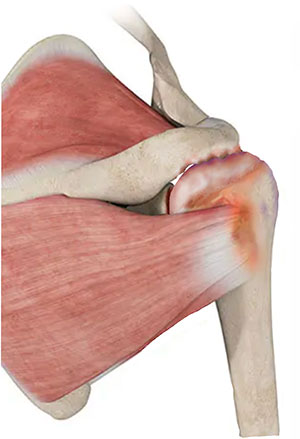Rotator Cuff Arthropathy More
By Roger C. Sohn, MD
What is Rotator Cuff Tear Arthropathy?
The shoulder is a shallow ball and socket joint. During normal motion, the shoulder is stabilized by 4 important muscles called the rotator cuff. Large tears in the rotator cuff can lead to abnormal motion and mechanics of the shoulder joint. Over time, this leads to a condition called rotator cuff tear arthropathy, which is a form of wear-and-tear arthritis caused by the rubbing of the ball against the acromion or the “roof” of the shoulder.
What Are The Symptoms of Rotator Cuff Tear Arthropathy?
Symptoms of rotator cuff tear arthropathy include pain, swelling, loss of motion, loss of strength, and a sensation of grinding or catching of the joint. Overhead activities of daily living such as bathing, dressing, and eating become increasingly difficult. In advanced cases, the shoulder can develop “pseudoparalysis” which is a profound inability to raise the arm.
How Is Rotator Cuff Tear Arthropathy Diagnosed?
The diagnosis of a rotator cuff tear arthropathy will be based on your history and your doctor’s physical examination. Your doctor will pay close attention to your shoulder mechanics and note which muscles are working. X-rays may be ordered to evaluate the joint for any bony abnormality or a high riding humerus, which is a sign of a torn rotator cuff. MRI and CT scans may also be ordered to confirm the diagnosis.
What Treatments Are Available For Rotator Cuff Tear Arthropathy?
Non-surgical treatment options include ice, heat, anti-inflammatory medications, steroid injections, and physical therapy with the goal being to preserve range of motion and stability.
Surgical treatment options may include:
- Arthroscopic Repairs: In less severe cases, a partial repair of the torn rotator cuff may be performed. Often, this will require additional allograft tissue or tendon transfers to augment the repair since the original rotator cuff usually is atrophied.
- Reverse shoulder replacement surgery: In most cases of rotator cuff tear arthropathy, a reverse shoulder replacement is required. The damaged ball and socket regions of the joint are removed and replaced by artificial components. Instead of replacing with similarly shaped components, the ball-shaped prosthesis is implanted at the glenoid cavity and the cup-shaped prosthesis is implanted at the end of the upper arm bone. This provides better stability and functionality without the need for a rotator cuff.
Postoperative Care
Following surgery, your arm may be placed in a sling. Physical therapy rehabilitation may begin the week after surgery to gradually improve your range of motion. Electrical stimulation and massage may also be helpful.


